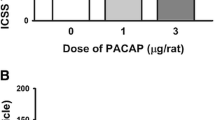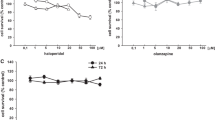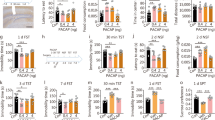Abstract
Pituitary adenylate cyclase-activating polypeptide (PACAP) has been postulated to be involved in the development of psychiatric disorders. PACAP-deficient mice show behavioral and neurophysiological abnormalities including novelty-induced hyperlocomotion, emotional lability, depression-like behaviors, and memory impairments that are ameliorated with atypical antipsychotic drugs (serotonin–dopamine antagonists). Targeted deletion of the PACAP receptor PAC1 leads to several of these abnormalities. Genetic studies in humans suggest that single nucleotide polymorphisms and copy number variations of the PACAP and/or PACAP receptor genes may be a genetic risk factor for psychiatric disorders including schizophrenia. Although these findings in patients need further replication and the exact mechanisms for PACAP-dependent psychomotor regulation remain to be determined, several potential mechanisms have been proposed. Thus, the convergent evidence from animal models and humans suggest that PACAP signaling can be an intrinsic regulator of psychoneurological functions and an attractive therapeutic target for the disorders.
Access provided by Autonomous University of Puebla. Download chapter PDF
Similar content being viewed by others
Keywords
- Pituitary adenylate cyclase-activating polypeptide (PACAP)
- Vasoactive intestinal peptide (VIP)
- PAC1 receptor
- VPAC2 receptor
- Animal model
- Behavior
- Endophenotype
- Psychiatric disorder
- Schizophrenia
- Post-traumatic stress disorder (PTSD)
- Antipsychotic drug
- Therapeutic target
Introduction
Pituitary adenylate cyclase-activating polypeptide (PACAP) [1] is widely distributed in the central nervous system and can act as a neurohormone, neurotransmitter, or trophic factor [2]. PACAP exerts multiple activities via three subtypes of G protein-coupled receptors, one PACAP-specific (PAC1) receptor and two receptors that are shared with vasoactive intestinal peptide (VIP) (VPAC1 and VPAC2). Accumulating evidence implicates PACAP signaling as an important regulator of psychiatric functions and suggests that genetic variation of PACAP and VPAC2 may be a risk factor for psychiatric disorders including schizophrenia and stress-related disorders. Such evidence has come from studies in both animal models and human clinical research, as well as through their bidirectional translation.
In this chapter, we briefly review our current knowledge in terms of the psychiatric implication of PACAP. Although we do not cover all contributions to the field, for detailed information, excellent reviews are available in this book and others [3–9].
Animal Studies
PACAP-deficient mice show behavioral and neurophysiological abnormalities that can potentially be correlated with psychiatric disorders and their related endophenotypes (Fig. 44.1). PACAP-deficient mice show hyperlocomotion and abnormally high-frequent jumping, increased novelty-seeking behavior, decreased anxiety-like behavior, and impaired social interaction [10–14]. The mutants have been shown to exhibit exaggerated depression-like behavior in the forced-swimming test [14, 15] and impaired prepulse inhibition of acoustic startle response [16]. However, these mice also demonstrated normal levels of depression-like behavior [17] and prepulse inhibition [13]. These discrepancies may reflect differences in behavioral protocols (behavioral tests each conducted in naïve mice vs. behavioral test batteries) and/or mouse genetic background. In addition, PACAP mutant mice show deficits in working memory [13, 18] and long-term potentiation in the dentate gyrus in vivo [19].
Behavioral phenotypes in PACAP- and PAC1 receptor-mutant mice, treatments ameliorative against the behavioral phenotypes of PACAP-knockout mice, and potential mechanisms of PACAP-dependent behavioral and neurophysiological regulation. LTP long-term potentiation, 5-HT serotonin, mGluR metabotropic glutamate receptor, icv intracerebroventricular
Mutant mice with complete (ubiquitous) or forebrain-specific deletion of the PACAP receptor PAC1 show a deficit in contextual fear conditioning, a hippocampal-dependent associative learning task, and impaired long-term potentiation at mossy fiber-CA3 synapses [20]. Hyperlocomotion and markedly reduced anxiety-like behavior have also been described in PAC1 receptor-deficient mice, but not in forebrain-specific PAC1 receptor mutant mice [21]. Furthermore, PAC1 receptor-deficient mice display markedly abnormal social behaviors [22].
The diversified behavioral and neurophysiological abnormalities in PACAP and PAC1 receptor mutant mice correlate with psychiatric disorders and their related endophenotypes and can be grouped into psychotic agitation (hyperlocomotion and abnormally high-frequent jumping), emotional (affective) components (anxiety-like behavior, depression-like behavior, and impaired social interaction), and cognitive deficits (memory deficits and impaired prepulse inhibition), although impaired social interaction may also be grouped as cognitive deficits.
Interestingly, some of the abnormalities in PACAP-deficient mice are clearly ameliorated by antipsychotic drugs, particularly with risperidone, an atypical antipsychotic drug and serotonin dopamine antagonist [10, 15, 16]. In addition, psychomotor and memory deficits in PACAP-deficient mice are ameliorated by MGS0028, a selective agonist of the metabotropic glutamate 2/3 receptor [23], and by SB-269970, a selective antagonist of the serotonin 7 receptor [18] (Fig. 44.1). Both the metabotropic glutamate 2/3 receptor and serotonin 7 receptor attract much attention owing to their therapeutic potential for psychiatric diseases. Thus, these results suggest that PACAP-deficient mice can be used as an animal model to develop new drugs for reversing neurobehavioral deficits.
Genetic Studies in Humans
Table 44.1 shows some, but not all, genetic variations of the genes for PACAP and the PACAP receptors, PAC1 and VPAC2, which have been suggested to be associated with an increased risk of psychiatric disorders and their postulated endophenotypes.
The single nucleotide polymorphisms (SNPs) in the PACAP gene (rs1893154 and rs2856966) and PAC1 receptor gene (rs2302475) were shown to be associated with schizophrenia [24]. Homozygous carriers of the G allele of the SNP rs1893154 of the PACAP gene had smaller bilateral hippocampal volumes and lower visual associative memory performance compared with A-carriers [24]. rs1893154 was also associated with major depressive disorder [25] (Table 44.1).
A copy number variation (CNV) of the PACAP gene owing to a partial trisomy 18p and monosomy 20p has been identified in two related patients. These patients have three copies of the PACAP gene and elevated PACAP concentrations in plasma and suffer from mental retardation, psychotic behavior, and hyperactive behavior. In addition to these neurological problems, the patients also have gastrointestinal and endocrinological problems, including a bleeding tendency with mild thrombocytopenia [26] (Table 44.1).
A female-specific association of the PACAP-PAC1 receptor pathway with post-traumatic stress disorder (PTSD) has been observed [27]. The SNP rs2267735 located in a putative estrogen response element of the PAC1 receptor gene is associated with PTSD diagnosis and symptoms. Recent functional magnetic resonance imaging studies showed that rs2267735 was associated with increased reactivity of the amygdala and hippocampus to threat stimuli and decreased functional connectivity between these brain regions in a traumatized cohort of women [28], as well as with decreased hippocampal activity during contextual fear conditioning in healthy females [29]. rs2267735 has also been shown to be associated with dark-enhanced startle in children [30] (Table 44.1). In addition to genetic variants, blood levels of PACAP have been shown to associate with PTSD in females, proposing that PACAP levels and PAC1 receptor gene SNPs may serve as biomarkers of PTSD [27].
The VPAC2 receptor, also known as VIPR2, is a common G-protein coupled receptor for PACAP and VIP [2]. Recently, the VPAC2 receptor has been shown to localize to primary cilia both in neurons and glial cells, malfunction of which is known to participate in neurological deficits [31]. Rare CNVs (copy number gains) at chromosome 7q36.3 were found to significantly associate with schizophrenia, which results in increased VPAC2 mRNA and cyclic AMP signaling in cultured lymphocytes from patients [32] (Table 44.1).
It should be noted that there are independent studies that do not replicate these associations [37, 38]. These clinical findings need further replication and investigation to clarify their functional importance.
Mechanistic Perspectives and Outlook
The exact mechanisms for PACAP-dependent psychomotor regulation remain to be determined, but several potential mechanisms have been proposed.
Abnormalities in PACAP-deficient mice show clear responses to environmental conditions during their juvenile stage with increased aggressiveness by isolation rearing and amelioration of hyperactivity, jumping behavior, depression-like behavior, and decreased social interaction by enriched environmental rearing [12]. Pharmacological studies have shown that PACAP heterozygous mutant mice show an exaggerated head-twitch response and prepulse inhibition disruption induced by the serotonin 2 agonist and hallucinogenic drug (±)-2,5-dimethoxy-4-iodoamphetamine (DOI) [33] and PACAP-deficient mice show diminished hypothermic response to serotonin 1A agonists [16]. Furthermore, the forced swim test-induced c-Fos expression was markedly blunted in several stress-related brain areas including the dorsal raphe nucleus and the bed nucleus of the stria terminalis in PACAP-deficient mice [14]. These results further support the validity of PACAP-deficient mice as an animal model to investigate mechanisms underlying gene-environment interactions and aberrant regulation of serotonergic function and neuronal plasticity (Fig. 44.1).
Disrupted-In-Schizophrenia 1 (DISC1) is a risk gene candidate for major psychiatric disorders. PACAP markedly decreases the association between DISC1 and DISC1-binding zinc finger protein (DBZ) leading to enhanced neurite outgrowth [34]. Increased expression of stathmin 1 induces abnormal arborization of axons in primary cultured hippocampal neurons. In PACAP-deficient mice, stathmin 1 is upregulated in the dentate gyrus at both the mRNA and protein levels [35]. In an independent study, stathmin 1 has been shown to be involved in the neurotrophic effect of PACAP in PC12 cells [36]. These results propose possible molecular mechanisms for altered PACAP signaling leading to abolished neuronal circuits and behavioral and neurophysiological abnormalities [9].
Although the results described above and in other literature provide diversified and dispersed features for the etiological mechanisms, taken collectively, the convergent evidence from animal models and clinical studies suggest that PACAP signaling can be an intrinsic regulator of psychoneurological functions and may propose an attractive therapeutic target for psychiatric disorders (Fig. 44.1).
Abbreviations
- CNV:
-
Copy number variation
- DBZ:
-
DISC1-binding zinc finger protein
- DISC1:
-
Disrupted-In-Schizophrenia 1
- PAC1 receptor:
-
PACAP receptor
- PACAP:
-
Pituitary adenylate cyclase-activating polypeptide
- PTSD:
-
Post-traumatic stress disorder
- SNP:
-
Single nucleotide polymorphism
- VIP:
-
Vasoactive intestinal peptide
- VPAC2 receptor:
-
VIP receptor 2
References
Miyata A, Arimura A, Dahl RR, Minamino N, Uehara A, Jiang L, et al. Isolation of a novel 38 residue-hypothalamic polypeptide which stimulates adenylate cyclase in pituitary cells. Biochem Biophys Res Commun. 1989;164:567–74.
Vaudry D, Falluel-Morel A, Bourgault S, Basille M, Burel D, Wurtz O, et al. Pituitary adenylate cyclase-activating polypeptide and its receptors: 20 years after the discovery. Pharmacol Rev. 2009;61:283–357.
Eiden LE. Neuropeptide-catecholamine interactions in stress. Adv Pharmacol. 2013;68:399–404.
Hammack SE, May V. Pituitary adenylate cyclase activating polypeptide in stress-related disorders: data convergence from animal and human studies. Biol Psychiatry. 2015;78:167–77.
Harmar AJ, Fahrenkrug J, Gozes I, Laburthe M, May V, Pisegna JR, et al. Pharmacology and functions of receptors for vasoactive intestinal peptide and pituitary adenylate cyclase-activating polypeptide: IUPHAR review 1. Br J Pharmacol. 2012;166:4–17.
Hashimoto H, Shintani N, Tanida M, Hayata A, Hashimoto R, Baba A. PACAP is implicated in the stress axes. Curr Pharm Des. 2011;17:985–9.
Matsuda K, Azuma M, Maruyama K, Shioda S. Neuroendocrine control of feeding behavior and psychomotor activity by pituitary adenylate cyclase-activating polypeptide (PACAP) in vertebrates. Obes Res Clin Pract. 2013;7:e1–7.
Pinhasov A, Nesher E, Gross M, Turgeman G, Kreinin A, Yadid G. The role of the PACAP signaling system in depression. Curr Pharm Des. 2011;17:990–1001.
Tohyama M, Miyata S, Hattori T, Shimizu S, Matsuzaki S. Molecular basis of major psychiatric diseases such as schizophrenia and depression. Anat Sci Int. 2015;90(3):137–43.
Hashimoto H, Shintani N, Tanaka K, Mori W, Hirose M, Matsuda T, et al. Altered psychomotor behaviors in mice lacking pituitary adenylate cyclase-activating polypeptide (PACAP). Proc Natl Acad Sci U S A. 2001;98:13355–60.
Colwell CS, Michel S, Itri J, Rodriguez W, Tam J, Lelievre V, et al. Selective deficits in the circadian light response in mice lacking PACAP. Am J Physiol Regul Integr Comp Physiol. 2004;287:1194–201.
Ishihama T, Ago Y, Shintani N, Hashimoto H, Baba A, Takuma K, et al. Environmental factors during early developmental period influence psychobehavioral abnormalities in adult PACAP-deficient mice. Behav Brain Res. 2010;209:274–80.
Hattori S, Takao K, Tanda K, Toyama K, Shintani N, Baba A, et al. Comprehensive behavioral analysis of pituitary adenylate cyclase-activating polypeptide (PACAP) knockout mice. Front Behav Neurosci. 2012;6:58.
Gaszner B, Kormos V, Kozicz T, Hashimoto H, Reglodi D, Helyes Z. The behavioral phenotype of pituitary adenylate-cyclase activating polypeptide-deficient mice in anxiety and depression tests is accompanied by blunted c-Fos expression in the bed nucleus of the stria terminalis, central projecting Edinger-Westphal nucleus, ventral lateral septum, and dorsal raphe nucleus. Neuroscience. 2012;202:283–99.
Hashimoto H, Hashimoto R, Shintani N, Tanaka K, Yamamoto A, Hatanaka M, et al. Depression-like behavior in the forced swimming test in PACAP-deficient mice: amelioration by the atypical antipsychotic risperidone. J Neurochem. 2009;110:595–602.
Tanaka K, Shintani N, Hashimoto H, Kawagishi N, Ago Y, Matsuda T, et al. Psychostimulant-induced attenuation of hyperactivity and prepulse inhibition deficits in Adcyap1-deficient mice. J Neurosci. 2006;26:5091–7.
Lehmann ML, Mustafa T, Eiden AM, Herkenham M, Eiden LE. PACAP-deficient mice show attenuated corticosterone secretion and fail to develop depressive behavior during chronic social defeat stress. Psychoneuroendocrinology. 2013;38:702–15.
Tajiri M, Hayata-Takano A, Seiriki K, Ogata K, Hazama K, Shintani N, et al. Serotonin 5-HT(7) receptor blockade reverses behavioral abnormalities in PACAP-deficient mice and receptor activation promotes neurite extension in primary embryonic hippocampal neurons: therapeutic implications for psychiatric disorders. J Mol Neurosci. 2012;48:473–81.
Matsuyama S, Matsumoto A, Hashimoto H, Shintani N, Baba A. Impaired long-term potentiation in vivo in the dentate gyrus of pituitary adenylate cyclase-activating polypeptide (PACAP) or PACAP type 1 receptor-mutant mice. Neuroreport. 2003;14:2095–8.
Otto C, Kovalchuk Y, Wolfer DP, Gass P, Martin M, Zuschratter W, et al. Impairment of mossy fiber long-term potentiation and associative learning in pituitary adenylate cyclase activating polypeptide type I receptor-deficient mice. J Neurosci. 2001;21:5520–7.
Otto C, Martin M, Wolfer DP, Lipp HP, Maldonado R, Schutz G. Altered emotional behavior in PACAP-type-I-receptor-deficient mice. Brain Res Mol Brain Res. 2001;92:78–84.
Nicot A, Otto T, Brabet P, Dicicco-Bloom EM. Altered social behavior in pituitary adenylate cyclase-activating polypeptide type I receptor-deficient mice. J Neurosci. 2004;24:8786–95.
Ago Y, Hiramatsu N, Ishihama T, Hazama K, Hayata-Takano A, Shibasaki Y, et al. The selective metabotropic glutamate 2/3 receptor agonist MGS0028 reverses psychomotor abnormalities and recognition memory deficits in mice lacking the pituitary adenylate cyclase-activating polypeptide. Behav Pharmacol. 2013;24:74–7.
Hashimoto R, Hashimoto H, Shintani N, Chiba S, Hattori S, Okada T, et al. Pituitary adenylate cyclase-activating polypeptide is associated with schizophrenia. Mol Psychiatry. 2007;12:1026–32.
Hashimoto R, Hashimoto H, Shintani N, Ohi K, Hori H, Saitoh O, et al. Possible association between the pituitary adenylate cyclase-activating polypeptide (PACAP) gene and major depressive disorder. Neurosci Lett. 2010;468:300–2.
Freson K, Hashimoto H, Thys C, Wittevrongel C, Danloy S, Morita Y, et al. The pituitary adenylate cyclase-activating polypeptide is a physiological inhibitor of platelet activation. J Clin Invest. 2004;113:905–12.
Ressler KJ, Mercer KB, Bradley B, Jovanovic T, Mahan A, Kerley K, et al. Post-traumatic stress disorder is associated with PACAP and the PAC1 receptor. Nature. 2011;470:492–7.
Stevens JS, Almli LM, Fani N, Gutman DA, Bradley B, Norrholm SD, et al. PACAP receptor gene polymorphism impacts fear responses in the amygdala and hippocampus. Proc Natl Acad Sci U S A. 2014;111:3158–63.
Pohlack ST, Nees F, Ruttorf M, Cacciaglia R, Winkelmann T, Schad LR, et al. Neural mechanism of a sex-specific risk variant for posttraumatic stress disorder in the type I receptor of the pituitary adenylate cyclase activating polypeptide. Biol Psychiatry. 2015;78(12):840–7.
Jovanovic T, Norrholm SD, Davis J, Mercer KB, Almli L, Nelson A, et al. PAC1 receptor (ADCYAP1R1) genotype is associated with dark-enhanced startle in children. Mol Psychiatry. 2013;18:742–3.
Soetedjo L, Glover DA, Jin H. Targeting of vasoactive intestinal peptide receptor 2, VPAC2, a secretin family G-protein coupled receptor, to primary cilia. Biol Open. 2013;2:686–94.
Vacic V, McCarthy S, Malhotra D, Murray F, Chou HH, Peoples A, et al. Duplications of the neuropeptide receptor gene VIPR2 confer significant risk for schizophrenia. Nature. 2011;471:499–503.
Hazama K, Hayata-Takano A, Uetsuki K, Kasai A, Encho N, Shintani N, et al. Increased behavioral and neuronal responses to a hallucinogenic drug in PACAP heterozygous mutant mice. PLoS One. 2014;9:e89153.
Hattori T, Baba K, Matsuzaki S, Honda A, Miyoshi K, Inoue K, et al. A novel DISC1-interacting partner DISC1-Binding Zinc-finger protein: implication in the modulation of DISC1-dependent neurite outgrowth. Mol Psychiatry. 2007;12:398–407.
Yamada K, Matsuzaki S, Hattori T, Kuwahara R, Taniguchi M, Hashimoto H, et al. Increased stathmin1 expression in the dentate gyrus of mice causes abnormal axonal arborizations. PLoS One. 2010;5:e8596.
Dejda A, Chan P, Seaborn T, Coquet L, Jouenne T, Fournier A, et al. Involvement of stathmin 1 in the neurotrophic effects of PACAP in PC12 cells. J Neurochem. 2010;114:1498–510.
Koga M, Ishiguro H, Horiuchi Y, Inada T, Ujike H, Itokawa M, et al. Replication study of association between ADCYAP1 gene polymorphisms and schizophrenia. Psychiatr Genet. 2010;20:123–5.
Chang SC, Xie P, Anton RF, De Vivo I, Farrer LA, Kranzler HR, et al. No association between ADCYAP1R1 and post-traumatic stress disorder in two independent samples. Mol Psychiatry. 2012;17:239–41.
Acknowledgments
This work was supported in part by the Japan Society for the Promotion of Science Grants-in-Aid for Scientific Research, KAKENHI, the Funding Program for Next Generation World-Leading Researchers, Grant No. LS081, and the Program for Advancing Strategic International Networks to Accelerate the Circulation of Talented Researchers, Grant No. S2603.
Author information
Authors and Affiliations
Corresponding author
Editor information
Editors and Affiliations
Rights and permissions
Copyright information
© 2016 Springer International Publishing Switzerland
About this chapter
Cite this chapter
Hashimoto, H. et al. (2016). Implications of PACAP Signaling in Psychiatric Disorders. In: Reglodi, D., Tamas, A. (eds) Pituitary Adenylate Cyclase Activating Polypeptide — PACAP. Current Topics in Neurotoxicity, vol 11. Springer, Cham. https://doi.org/10.1007/978-3-319-35135-3_44
Download citation
DOI: https://doi.org/10.1007/978-3-319-35135-3_44
Published:
Publisher Name: Springer, Cham
Print ISBN: 978-3-319-35133-9
Online ISBN: 978-3-319-35135-3
eBook Packages: Biomedical and Life SciencesBiomedical and Life Sciences (R0)





